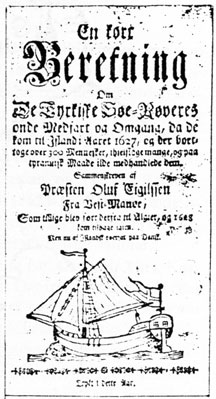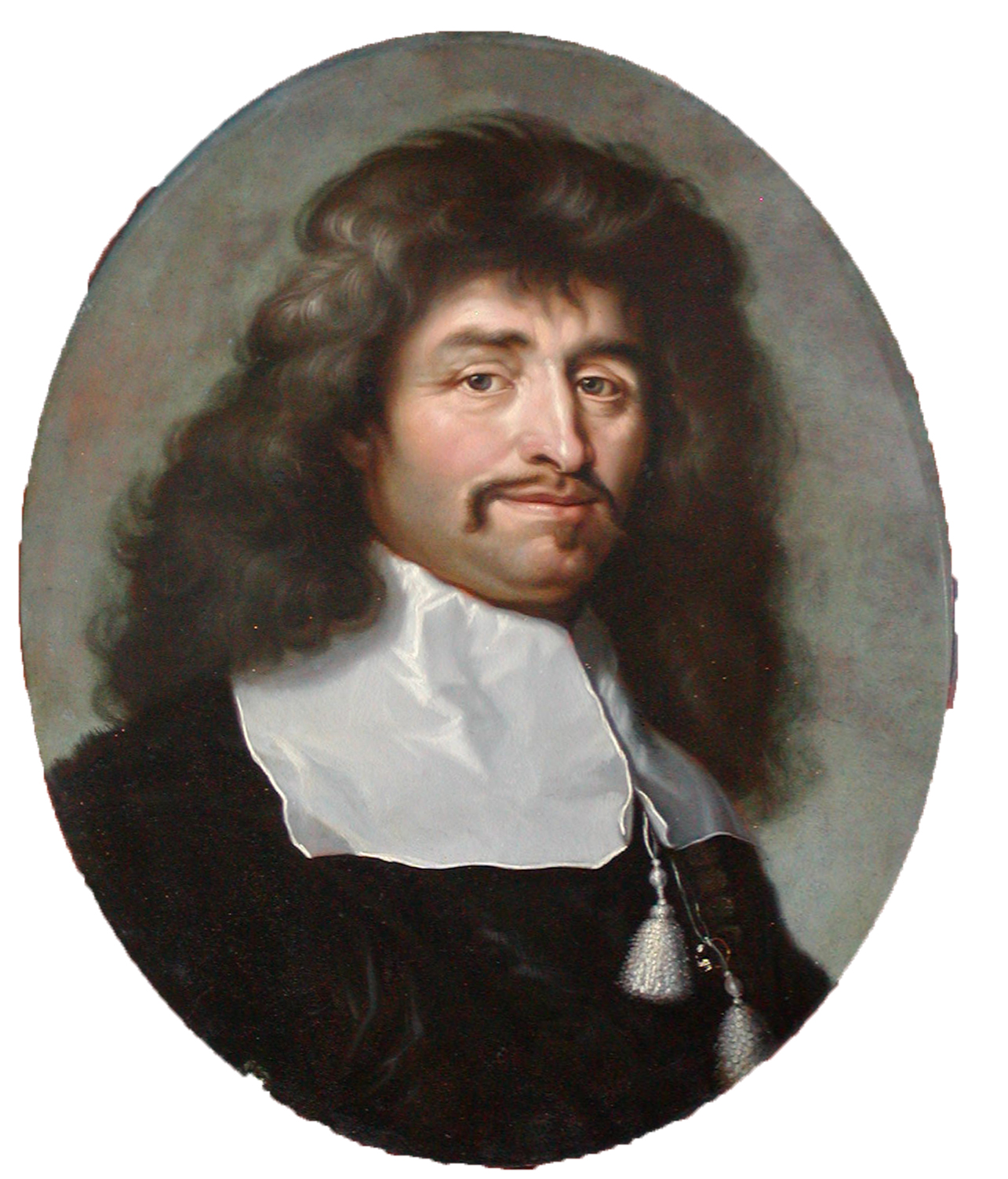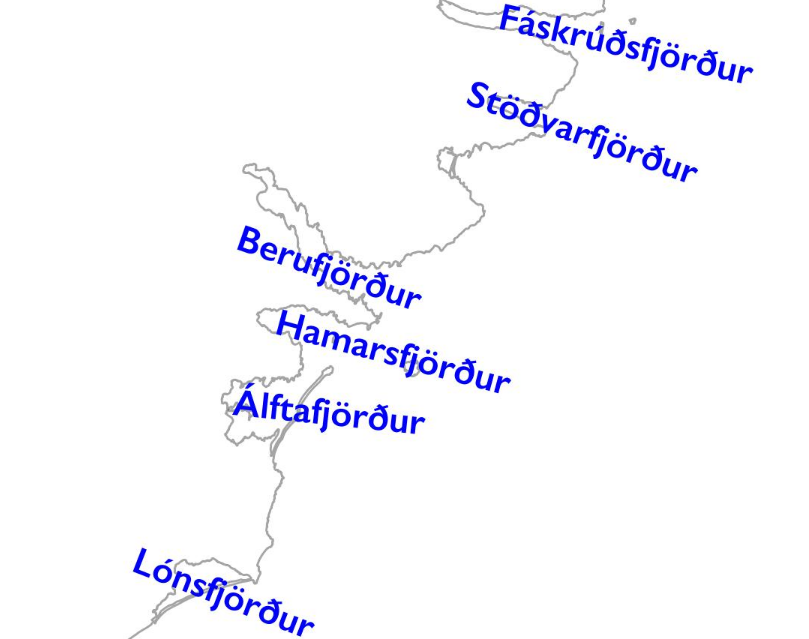|
The Turkish Abductions
The Turkish Abductions ( is, Tyrkjaránið) were a series of slave raids by pirates from Northwest Africa that took place in Iceland in the summer of 1627. The pirates came from the cities of Algiers and Salé. They raided Grindavík, the East Fjords, and Vestmannaeyjar. About 50 people were killed and close to 400 captured and sold into slavery. A ransom was eventually paid, 9 to 18 years later, for the return of 50 individuals. The label "Turkish" does not refer to Turkey; at the time it was a general term for all Muslims in the Mediterranean region since the majority were a part of the Ottoman Empire. During the 17th century, the majority of those called "Turks" in Algeria, were European Christians that had converted to Islam. Raids The Barbary pirates came to Iceland in two groups: the first group was from Salé and the second one, which came a month later, was from Algiers. The commander of the group from Salé was a Dutchman known as Murat Reis, who had himse ... [...More Info...] [...Related Items...] OR: [Wikipedia] [Google] [Baidu] |
Murat Reis The Younger
Jan Janszoon van Haarlem, commonly known as Reis Mourad the Younger (c. 1570 – c. 1641), was an Ottoman and Salé Rovers Dutch pirate in Algeria and Morocco who converted to Islam after being captured by a Moorish state in 1618. He began serving as a pirate, one of the most famous of the 17th-century "Salé Rovers". Together with other corsairs, he helped establish the independent Republic of Salé at the city of that name, serving as the first President and Commander. He also served as Governor of Oualidia. Early life Jan Janszoon van Haerlem was born in Haarlem in 1570, which is in Holland, then a province ruled by the Habsburg monarchy. The Eighty Years War between Dutch rebels and the Spanish Empire under King Philip II had started seven years before his birth; it lasted all his life. Little is known about his early life. He married Soutgen Cave in 1595 and had two children with her, Edward and Lysbeth. Privateering In 1600, Jan Janszoon began as a Dutch privateer saili ... [...More Info...] [...Related Items...] OR: [Wikipedia] [Google] [Baidu] |
Hallgrímur Pétursson
Hallgrímur Pétursson (1614 – 27 October 1674) was an Icelandic poet and a minister at Hvalsneskirkja and Saurbær in Hvalfjörður. Being one of the most prominent Icelandic poets, the Hallgrímskirkja in Reykjavík and the Hallgrímskirkja in Saurbær are named in his honor. He was one of the most influential pastors during the Age of Orthodoxy (1580–1713). Because of his contributions to Lutheran hymnody, he is sometimes called the Icelandic Paul Gerhardt. Biography left, The Hallgrímskirkja in Saurbær. Hallgrímur Pétursson was likely born at Gröf in Skagafjörður. He grew up at Hólar, where his father was the bell-ringer and his cousin Guðbrandur Þorláksson the resident bishop. As a young man, he left Hólar for unknown reasons and travelled to mainland Europe, possibly to learn the blacksmith trade. He ended in Copenhagen, where Brynjólfur Sveinsson sponsored him to attend the seminary at the Church of Our Lady. Brynjólfur had family connections to ... [...More Info...] [...Related Items...] OR: [Wikipedia] [Google] [Baidu] |
Guðríður Símonardóttir
Guðríður Símonardóttir (1598 – December 18, 1682) was an Icelandic woman who was one of 242 people abducted from the Westman Islands, Iceland in 1627 in a raid by Barbary pirates."Saurbaer" , Nordic Adventure Travel, Iceland These raids came to be known as the Turkish abductions. After being held as a slave and concubine for nearly a decade, she was one of a few captives ransomed by the Danish king. She returned to Iceland, marrying the young theology student , who became known for his poetry and hymns. Life Guðríður was the wife of ...[...More Info...] [...Related Items...] OR: [Wikipedia] [Google] [Baidu] |
Glückstadt
Glückstadt (; da, Lykstad) is a town in the Steinburg district of Schleswig-Holstein, Germany. It is located on the right bank of the Lower Elbe at the confluence of the small Rhin river, about northwest of Altona. Glückstadt is part of the Hamburg Metropolitan Region (''Metropolregion Hamburg''). History Glückstadt was founded in 1617 on the marsh lands along the Elbe by the Duke of Holstein, King Christian IV of Denmark, who had levees and fortifications built as well as a ducal residence. Its name translates to English literally as "Luck City" or "Fortune City". As Christian IV promised the settlers tax exemption and freedom of religion, Glückstadt soon became an important trading centre, intended to compete with the Imperial city of Hamburg, located upstream on the Elbe. Calvinists, Remonstrants and Mennonites (Anabaptists) from the Netherlands settled here, as well as Sephardic Jews and Catholics. After the king had interfered in the Thirty Years' War, the town ... [...More Info...] [...Related Items...] OR: [Wikipedia] [Google] [Baidu] |
Copenhagen
Copenhagen ( or .; da, København ) is the capital and most populous city of Denmark, with a proper population of around 815.000 in the last quarter of 2022; and some 1.370,000 in the urban area; and the wider Copenhagen metropolitan area has 2,057,142 people. Copenhagen is on the islands of Zealand and Amager, separated from Malmö, Sweden, by the Øresund strait. The Øresund Bridge connects the two cities by rail and road. Originally a Viking fishing village established in the 10th century in the vicinity of what is now Gammel Strand, Copenhagen became the capital of Denmark in the early 15th century. Beginning in the 17th century, it consolidated its position as a regional centre of power with its institutions, defences, and armed forces. During the Renaissance the city served as the de facto capital of the Kalmar Union, being the seat of monarchy, governing the majority of the present day Nordic region in a personal union with Sweden and Norway ruled by the Danis ... [...More Info...] [...Related Items...] OR: [Wikipedia] [Google] [Baidu] |
Ólafur Egilsson
Ólafur Egilsson (1564 – 1 March 1639) was an Icelandic Lutheran minister. In 1627, he was abducted, along with his wife and two sons, by Barbary Pirates under the Ottoman Empire during their raid on Vestmannaeyjar. The raid is known in Icelandic history as '' Tyrkjaránið'' ( The Turkish abductions). He returned to Vestmannaeyjar in 1628 but his wife Ásta Þorsteinsdóttir did not return until 1637 and his sons never returned. He later wrote a memoir of his abduction and return, which was published both in Iceland and in Denmark. Ólafur Egilsson and his wife Ásta Þorsteinsdóttir are major characters in the 2018 historical novel ''The Sealwoman's Gift'' by Sally Magnusson. Published work * Egilsson, Ólafur (1741). ''En kort Beretning Om De Tyrkiske Søe-Røveres onde Medfart og Omgang, da de kom til Island i Aaret 1627, og der borttoge over 300 Mennesker, ihjelsloge mange, og paa tyrannisk Maade ilde medhandlede dem : sammenskreven af Præsten Oluf Eigilssen fra Ves ... [...More Info...] [...Related Items...] OR: [Wikipedia] [Google] [Baidu] |
Islam
Islam (; ar, ۘالِإسلَام, , ) is an Abrahamic religions, Abrahamic Monotheism#Islam, monotheistic religion centred primarily around the Quran, a religious text considered by Muslims to be the direct word of God in Islam, God (or ''Allah'') as it was revealed to Muhammad, the Muhammad in Islam, main and final Islamic prophet.Peters, F. E. 2009. "Allāh." In , edited by J. L. Esposito. Oxford: Oxford University Press. . (See alsoquick reference) "[T]he Muslims' understanding of Allāh is based...on the Qurʿān's public witness. Allāh is Unique, the Creator, Sovereign, and Judge of mankind. It is Allāh who directs the universe through his direct action on nature and who has guided human history through his prophets, Abraham, with whom he made his covenant, Moses/Moosa, Jesus/Eesa, and Muḥammad, through all of whom he founded his chosen communities, the 'Peoples of the Book.'" It is the Major religious groups, world's second-largest religion behind Christianity, w ... [...More Info...] [...Related Items...] OR: [Wikipedia] [Google] [Baidu] |
Religious Conversion
Religious conversion is the adoption of a set of beliefs identified with one particular religious denomination to the exclusion of others. Thus "religious conversion" would describe the abandoning of adherence to one denomination and affiliating with another. This might be from one to another denomination within the same religion, for example, from Baptist to Catholic Christianity or from Sunni Islam to Shi’a Islam. In some cases, religious conversion "marks a transformation of religious identity and is symbolized by special rituals". People convert to a different religion for various reasons, including active conversion by free choice due to a change in beliefs, secondary conversion, deathbed conversion, conversion for convenience, marital conversion, and forced conversion. Proselytism is the act of attempting to convert by persuasion another individual from a different religion or belief system. Apostate is a term used by members of a religion or denomination to refer to so ... [...More Info...] [...Related Items...] OR: [Wikipedia] [Google] [Baidu] |
Heimaey
Heimaey (), is an Icelandic island. At , it is the largest island in the Vestmannaeyjar archipelago, and the largest and most populated island off the Icelandic coast. Heimaey is off the south coast of Iceland. It is the only populated island of the Vestmannaeyjar islands, with a population of 4,414. The Vestmannaeyjar Airport and the Westman Islands Golf Club taken together cover a good portion of the island. In January 1973, lava flow from nearby Eldfell destroyed half the town and threatened to close its harbour, its main income source. An operation to cool the advancing lava with sea water saved the harbour. History Abducted from the north of Ireland, the slaves were called westmen (Vestmenn), as before discovering Iceland, Ireland was the most western part of the world known to northern Europeans then (c. 840). The slaves went ashore at Heimaey and took shelter in the hills. Ingólfur hunted them and killed them in revenge for their murdering his foster brother. In ... [...More Info...] [...Related Items...] OR: [Wikipedia] [Google] [Baidu] |
Berufjörður
Berufjörður () is a fjord in Eastern Iceland. It is about long and wide. The village Djúpivogur (pop. 456) is located on its western shores. Mt. Búlandstindur which is above sea level is located west of the fjord. Route 1 passes on its shores. See also * Djúpivogur Djúpivogur () is a small town and municipality (Djúpavogshreppur ) located on a peninsula in the Austurland region in eastern Iceland, near the island of Papey and on the fjord Berufjörður. The municipality was formed by the merger of rural ... * Búlandstindur * Eastern Iceland References External links Fjords of Iceland Eastern Region (Iceland) {{Iceland-fjord-stub ... [...More Info...] [...Related Items...] OR: [Wikipedia] [Google] [Baidu] |
Southern Peninsula (Iceland)
Southern Peninsula ( is, Suðurnes ) is an administrative unit and part of Reykjanesskagi (pronounced ), or Reykjanes Peninsula, a region in southwest Iceland. It was named after Reykjanes, the southwestern tip of Reykjanesskagi. The region has a population of 27,829 (2020) and is one of the more densely populated parts of the island. The administrative centre is Keflavík, which had 7,000 residents when it merged with the nearby town of Njarðvík and Hafnir in 1995 to create Reykjanesbær, which is the largest settlement outside the Greater Reykjavík area; in 2018 the region had a population of 17,805. The region is the location of Keflavík International Airport, the major point of entry for Iceland. Some fishing towns, such as Grindavík, Njarðvík and Sandgerði are situated on the peninsula. The peninsula is marked by active volcanism under its surface and large lava fields, allowing little vegetation. There are numerous hot springs in the southern half of the peninsu ... [...More Info...] [...Related Items...] OR: [Wikipedia] [Google] [Baidu] |


.jpg)
.jpg)

